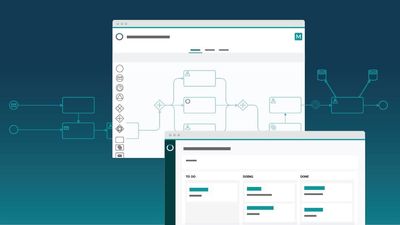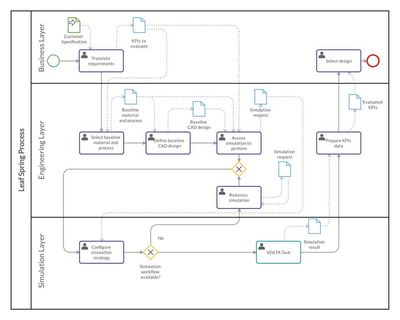From task oriented to process driven: business process management in VOLTA
Written by Nela Lazarevic
26 October 2021 · 5 min read

The fast-evolving use of AI-driven decision-making has brought us to think of product development as a fully machine-driven process.
But the role of individuals in product development is still as essential as it’s ever been. ESTECO Technology has been helping engineers advance innovation through pioneering process automation and design optimization technology for over two decades. Smart optimization algorithms, machine learning libraries, and automation of simulation workflows have been our company's daily bread since the late 1990s.
modeFRONTIER workflows integrate with all the most popular third-party solvers to guarantee a seamless simulation process. This allows engineers to automate repetitive tasks and focus on what really matters - designing innovative products.
VOLTA SPDM platform has taken this concept to the next level, enabling enterprise-wide collaboration with full traceability of simulation data and granular access based on user roles.
Now we’re taking VOLTA to the next level, by introducing a business process management layer on top of the SPDM capabilities. One could say that we’re bringing people into the loop of the product design process. But the truth is that people have always been in the loop. What’s new is that we’re bringing the management of human and machine-operated tasks on top of the existing simulation workflows. This way, teams can rely on VOLTA as a single source of truth for all aspects of the design process.
Business Process Management (BPM) is a discipline that uses various methods to discover, model, analyze, measure, improve and optimize business processes. A business process coordinates the behavior of people, systems, information and things to produce business outcomes in support of a business strategy.
Six benefits of business process management in VOLTA
1. Power up the existing Simulation Process and Data Management (SPDM) capabilities of VOLTA
Business process management capabilities in VOLTA enable you to extract more value from the VOLTA Simulation Process and Data Management (SPDM) capabilities. How? By bringing the sequencing and orchestration of both human and machine-operated tasks.
The granularity of user access and the data sharing capabilities, already available in VOLTA Data Manager, can now be further exploited through the automated business process workflows. The information will still be stored within the Data Manager, be it excel sheets, simulation workflows, raw data, or PDFs with regulation specifications. The VOLTA Process Manager will reference the right documents at the right time and the right users at the right time. This now happens through the VOLTA service task - an element of the business process workflow that works as a link between the business process workflow and any VOLTA project. It’s dedicated to the launch of simulations in VOLTA.
The simulation workflow in VOLTA is where you’ll keep setting up all the aspects of your simulation process from third party tool integration to simulation automation. On the other hand, the business process workflow is where you can now map out, sequence and automate all the human tasks associated with the simulation-lead product design phase.
2. Automate repetitive tasks and formalize best practices
Let’s say you’re an engineer that runs a certain simulation repetitively with certain regularity. What you’re doing is part of a business process and you can model it in VOLTA modeler so that you no longer have to execute those runs manually. Once modeled, the steps included in this process, from scheduled run of the simulation to report generation and sharing, can now be fully automated, freeing up time spent on “mechanic”, repetitive tasks.
The same principle applies to bigger chunks of business processes, including multiple players, even geographically remote and belonging to different disciplines. Processes can be mapped and then automatically run, increasing the speed of operations, but at the same time the precision of the execution. Once the processes are fully mapped, there is less possibility that engineers will waste precious time working on the wrong version of the file or making sure they got the right one. VOLTA process manager will automatically run all human and machine tasks that you modeled, and it will trigger the right users to provide the necessary information at the right moment.
3. Spot bottlenecks and maximize efficiency
All organizations have processes. Many of them are not mapped. Some can be run simultaneously in different departments and this is where the need for having documented processes is higher.
Once human steps are mapped along with those executed within the machine-performed simulation workflow chains, you will have the entire picture of how your team, external department interact and contribute to the simulation-lead design process. Interactions among expertise domains and departments will emerge more clearly, not only in terms of organizational charts but in terms of their timed and sequenced input within a specific business process. On an individual level, it becomes easier to understand how their role contributes to the bigger picture. On the team level, interactions within the team and across departments become more transparent and streamlined. Modeled processes will run multiple times and logs will be saved from each process instance, resulting in increased visibility and higher process control. It’s easier to spot inefficiencies and implement improvements.
4. Cut silos
Organizations traditionally approach the interactions among teams from the point of view of the organizational chart. Business process management as discipline advocates for a process-oriented approach, where every process has a client at its beginning and its end. A client can be both internal and external. More strategic, higher-level processes will have external clients at their beginning and their end, while most operational processes will deal with internal clients, be it managers or different departments, simulation expert teams, CAE or MDO experts. Whether internal or external, the process-oriented view helps overcome the siloed thinking, aligning each player within the common objective of reaching a process goal.

Image: courtesy of NAFEMS
5. Scale best practices
In a context where manufacturing companies face higher pressure than ever to innovate faster and cut development time, a process-oriented view enables organizations to be more agile and flexible while maintaining structured execution of their processes. Repetitive tasks are automated, and once mapped they can be called for execution endless times and even as parts of different processes. Changing parts of the process is possible while maintaining the rest without having to remodel everything from scratch.
6. Increase process governance and visibility across departments
Legacy IT solutions have long been operating to solve issues of task automation and tool integration. But the business process management modules in VOLTA take it to the next level.
Business process modeling and notation, BPMN is a widely used business process modeling standard. It was designed with automation in mind and as a “bridge” between business and technical individuals and teams.
Break down silos across engineering departments, capture information and drive optimal decision making


